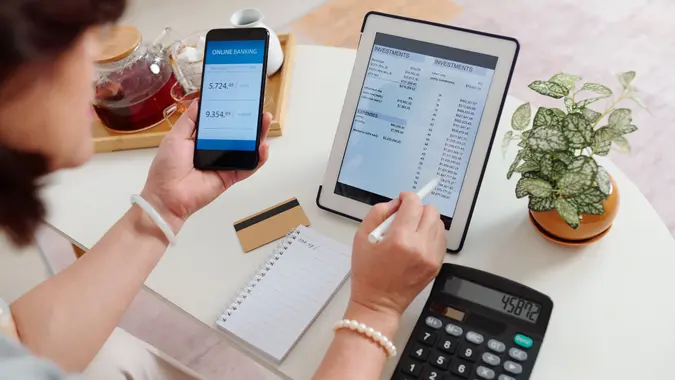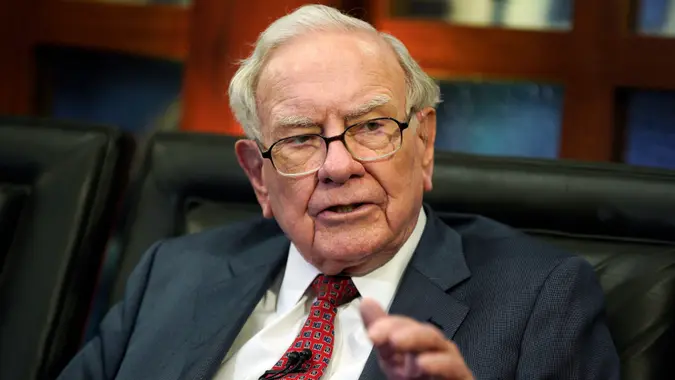How To Invest in Silver: 5 Ways To Get Started in 2025

Commitment to Our Readers
GOBankingRates' editorial team is committed to bringing you unbiased reviews and information. We use data-driven methodologies to evaluate financial products and services - our reviews and ratings are not influenced by advertisers. You can read more about our editorial guidelines and our products and services review methodology.

20 Years
Helping You Live Richer

Reviewed
by Experts

Trusted by
Millions of Readers
Silver has long been considered a smart hedge against inflation and a way to diversify traditional stock-heavy portfolios. Whether you’re thinking about buying physical silver, investing through ETFs or adding it to a retirement account, there are several ways to get started. Here’s a quick side-by-side look at five popular strategies — and what they’re best suited for.
| Method | Best For | Pros | Cons |
|---|---|---|---|
| Invest in silver exchange-traded funds (ETFs) | Easy investing with no physical silver purchase | -Easy to trade -Relatively low cost |
-Fees -Potentially low trading volume |
| Buy silver mining stocks | Ability to hand-select companies you invest in | -Good return potential -Might earn dividends |
-Indirect exposure to silver -Company-specific risks like management and operational costs |
| Trade silver futures or options | High growth potential for experienced investors | -Potentially high gains | -Risk of losing more than you invested |
| Consider a silver individual retirement account (IRA) | Retirement portfolio diversification | -Tax-advantaged -Uses standard IRAs |
-Volatility -Strict rules -Fees |
| Buy physical silver | Investing in a tangible asset | -Ownership of tangible asset -Can be used for bartering or emergencies |
-Requires secure storage -Dealer premiums -Price volatility |
1. Silver ETFs
Silver ETFs are funds that track the price of silver and allow you to invest without holding the physical metal.
How To Invest in Silver ETFs
You can purchase silver ETFs through a brokerage account — just like individual stocks — using platforms like Fidelity, E*TRADE or Charles Schwab. Once your account is funded, simply search for an ETF and place a trade.
Different Types of Silver ETFs
- Physical silver: Some ETFs hold physical silver bullion, like iShares Silver Trust (SLV).
- Silver mining stocks: ETFs like Global X Silver Miners (SIL) track the performance of silver mining companies.
- Both physical and mining exposure: Sprott Silver Miners & Physical Silver ETF (SLVR) combines physical silver with silver mining investments.
2. Silver Mining Stocks
Instead of investing in silver directly, you can invest in companies that mine and refine silver, such as Wheaton Precious Metals, Fresnillo and Pan American Silver.
Silver mining stocks offer the potential for higher returns, especially if the company pays dividends. But if the company faces management or operational challenges, share prices could fall even if silver prices are rising.
How To Invest in Silver Mining Stocks
These stocks are available through any investment brokerage — just search for the company name and place your order.
3. Silver Futures and Options
Silver futures are contracts where investors agree to buy or sell silver on a specific future date at a set price. These contracts offer opportunities regardless of which way prices are moving.
For more flexibility, you might consider futures options. Options give you the right to buy or sell at any time during the term of the contract.
Futures trading is high-risk and complex, best suited for experienced investors who understand market movements.
How To Trade Silver Futures and Options
To start, open an account with a futures commission merchant, such as Charles Schwab, which serves as an intermediary that executes your trades.
Futures trade on margin, with funds you borrow from the broker, so you’ll need to meet the broker’s margin requirements.
Research contracts to find an appropriate investment in terms of:
- Contract size: Typically specifies the amount of silver per contract, such as 100 troy ounces
- Notional value: Represents the total value of the underlying silver in the contract
- Minimum price fluctuation: Measured in units called ticks, indicating the smallest possible price movement
Follow the merchant platform’s instructions for placing orders.
4. Consider a Silver IRA
You can use a self-directed individual retirement account (SDIRA) to invest in alternative assets, including silver.
With these accounts, a custodian or trustee purchases the silver and stores it on your behalf. The custodian has the title to any silver in its custody.
How To Invest in Silver IRAs
Before opening a self-directed IRA, research several custodians, and make sure they’re on the IRS’s list of approved non-bank self-directed trustees and custodians.
Next, open a traditional, Roth or other acceptable type of IRA and fund the account.
Purchase silver investments from the investment choices offered by the custodian, and agree to allow a third-party depository to store your holdings.
5. Physical Silver — Coins and Bars
Purchasing physical silver is a direct way to own the metal. You can buy silver in the form of:
- Bullion coins: Examples include the American Silver Eagle and Canadian Maple Leaf coins
- Silver bars: Available in various weights, silver bars usually have lower premiums than coins
- Junk silver: Pre-1965 U.S. dimes, quarters and half-dollars that contain 90% silver
How To Buy Physical Silver
If you’re looking to invest in physical silver, first decide where to buy it:
- Online precious metal dealer
- Local coin shop
- Bank and mint
Next, research a few sources. Look for accreditation by the Professional Numismatists Guild (PNG) or the Industry Council for Tangible Assets (ICTA) if you’ll buy silver from an online dealer or local shop.
Finally, compare buy and sell prices from multiple dealers, and avoid dealers that charge excessive premiums.
How To Store Your Physical Silver
Once you’ve bought silver, you’ll need to store it. Options include:
- Home storage: Fireproof safe for small investments
- Bank safety deposit box: Secure but less accessible
- Private vault service: Third-party storage for larger holdings
What Affects Silver Prices?
Silver prices fluctuate more than gold due to a smaller market size and industrial demand.
- Economic uncertainty: Silver prices often rise when the economy struggles.
- Inflation and interest rates: Low interest rates generally favor silver.
- Industrial demand: If demand for silver in electronics drops, prices can fall.
Costs, Fees and Risks To Consider When Investing in Silver
Each method for investing in silver has costs, fees and risks to consider before you buy.
Physical Silver
- Dealer markups add to the cost of buying silver and reduce your profits when you sell.
- You’ll need insurance and storage to protect your investment.
- There’s no guarantee that your silver’s value will appreciate enough to cover all the costs.
Silver Stocks and ETFs
- There is no commission with some brokers, but ETFs include expense ratios and spreads between purchase and sale prices.
- Silver prices may fall, impacting returns.
- Company-specific risks, like poor management or operational challenges, can impact gains.
Silver Futures
- You’ll pay contract fees — Schwab, for example, charges $2.25 plus exchange and regulatory fees.
- You must maintain a certain level of reserves in a margin account.
- Margin calls can trigger forced sales and potential losses beyond your initial investment.
Silver IRA
- Application fees can cost you around $50.
- You’ll also pay annual account fees of around $75 to a few hundred dollars, plus storage fees that can cost up to 1% of the value of your silver.
- The custodian will also charge a transaction fee, often of about $40, to buy or sell silver on your behalf.
- The fees could more than offset any price appreciation.
Which Silver Investment Is Right for You?
The best silver investment for you depends on your investing goals and preferences, budget, risk tolerance and other factors.
- Does owning a tangible asset you can see and touch matter to you? Physical silver might be the right investment for you.
- Do you want a low-cost, highly liquid passive investment? Consider silver ETFs.
- Are you most comfortable with traditional investment assets? Research silver mining stocks to see if they’re a good fit for your portfolio.
- Are you an experienced investor looking for big returns? Futures, with or without options, could be your best choice.
- Would you like your silver investment to be tax-advantaged? Silver IRA contributions and growth are tax-deferred.
Tips for First-Time Silver Investors
Investing in silver can be intimidating, but the right approach simplifies the process and increases the chances that your investments will pay off.
Set investment goals and stick to them:
- Define whether you’re investing for short-term gains or long-term stability.
- Track silver market trends before making big investments.
Diversify your silver investments:
- Don’t put all your money into silver — balance with other assets like stocks and bonds.
- Consider a mix of physical silver and ETFs for liquidity and security.
Track silver prices and trends:
- Follow silver price charts on sites like Kitco or Bloomberg.
- Monitor supply-demand trends in industrial and investment sectors.
Is Silver a Good Investment in 2025?
Silver is considered a precious metal and an industrial commodity, meaning its value comes from both investment demand and its use in manufacturing. With the right strategy and due diligence, silver can be an excellent addition to your portfolio.
Investing in Silver: FAQ
Have questions about silver investing? Here’s what to know before adding this precious metal to your portfolio.- What is the best way to invest in silver?
- Stocks and ETFs are two of the easiest ways to invest in silver, but owning physical silver is also appealing to some investors.
- Is it a good idea to invest in silver?
- Generally speaking, yes it can be a smart to invest in silver. It is volatile, but demand is strong, and you have a choice of ways to invest.
- Is silver better than gold for investing?
- When considering gold vs. silver, silver might be better because it's less expensive and has industrial uses that drive demand.
- How much silver should I have in my portfolio?
- Experts generally recommend that you keep no more than 5% of your portfolio in precious metals, including silver.
Vance Cariaga contributed to the reporting for this article.
Information is accurate as of July 15, 2025.
Our in-house research team and on-site financial experts work together to create content that’s accurate, impartial, and up to date. We fact-check every single statistic, quote and fact using trusted primary resources to make sure the information we provide is correct. You can learn more about GOBankingRates’ processes and standards in our editorial policy.
- APMEX "Silver Spot Price"
- Charles Schwab. 2023. "The Basics of Trading Futures Contracts."
- CompaniesMarketCap. "Largest silver mining companies by Market Cap."
- TitanEdge. "How To Invest In Silver: Everything You Need To Start Silver Trading."
- Charles Schwab. "Futures."
- Charles Schwab. "Futures contract details."
- Charles Schwab. 2025. "ETFs: Expense Ratios and Other Costs."
 Written by
Written by  Edited by
Edited by 

























